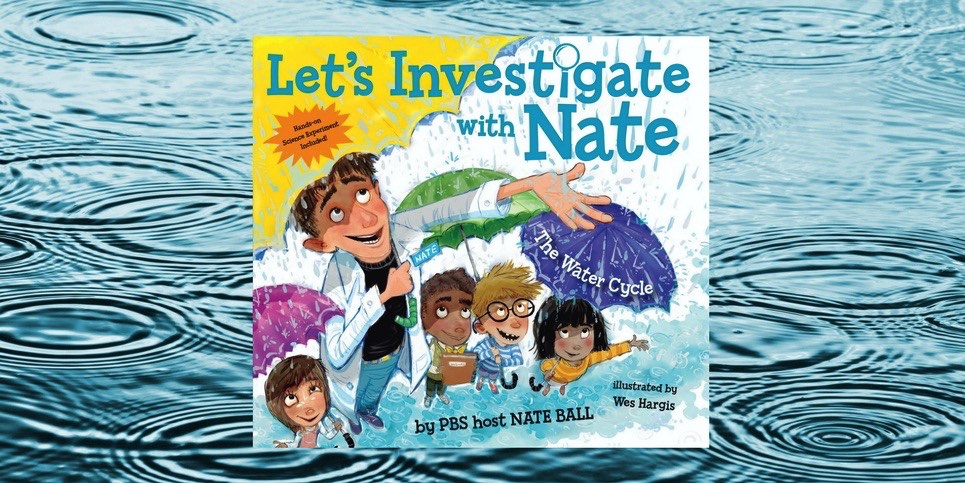Nate Ball | The Children’s Book Review | September 20, 2016
Nate Ball is the Emmy Award-winning host of PBS’s Design Squad and Design Squad Nation. Here are his 5 truly awesome-sauce tips for inspiring curious young scientists …
5. Cultivate Their Natural Curiosity
Notice what they’re drawn to, and set up opportunities for them to enjoy pursuing those interests in greater depth. All kids are curious, and a self-driven line of investigation will yield a much greater impact on kids’ learning and retention than a topic chosen by someone else. Pay attention to your young scientist’s interests and suggest projects or experiments that relate to their natural inclinations.
4. Go on the Journey Alongside Them, but Let Them Lead the Way
It’s always exciting to reach the end of a line of inquiry – but don’t rush it, and especially make sure the kid is leading the pace and direction themselves. Careful investigation often takes persistence and patience, and getting practice with those critical skills can be far more valuable in the long term than just reaching the end of an experiment. So even if you see kids taking an inquiry in a different direction, don’t just try to pull them back toward the original aim of the experiment. Instead, ask gently open-ended questions that help them come to new understandings themselves. And it may be the case that their own course of experimentation may be much more interesting and exciting to them than the original plan anyway!
3. Keep it hands-on!
Let it be gooey and messy! It’s OK if everyone has to wash hands (and some tables and chairs) afterward. The hands-on tactile participation in science can be one of the most gratifying parts. But this can also be one of the hardest as a parent, teacher or mentor. Letting kids be kids is a crucial part of helping them develop their own positive relationship to experimentation and science. Setting up the environment to be OK for the naturally messy aspects of hands-on projects will help them feel permitted to explore in their own way. And it will help you have more fun too
2. Ask Questions That Facilitate Deeper Thought
A big part of science is learning to ask better questions. Instead of just making direct observations about what happened in an experiment (and making a judgment about if it was “right or wrong” or “true or false”), probe around what was observed, coaching your young investigator to be inquisitive. A good question can open up a whole new line of insights that feed more questions that feed more insights, and so on.
1. Focus on the Experience, Not the Results
With young scientists, it’s far more important to cultivate a positive relationship to the process of doing science than it is to reach a specific experiment outcome. Some experiments take a lot of tries to generate a meaningful result. Helping kids respond to surprises and unexpected outcomes with an exclamation of “How fascinating! Why do you think it happened that way?” is a skill that goes far beyond science, and will continue to pay dividends throughout their lives. If after the experiment – regardless of the outcome – your young scientists want to come back for more, it’s already a tremendous success.
###
Written by Nate Ball
Illustrated by Wes Hargis
Publisher’s Synopsis: Bill Nye the Science Guy meets The Magic School Bus!
This is the first book in a new STEM-based picture book series from the Emmy Award-winning host of PBS’s Design Squad and Design Squad Nation, Nate Ball. With a lively cast of characters and vibrant illustrations by Wes Hargis, it’s an adventure in learning!
Ever wonder where water comes from and where it goes? Or why sometimes it rains and sometimes it snows? Then join Nate Ball and his crack team of curious scientists as they shrink down smaller than a raindrop to see firsthand what the water cycle is all about.
Ages 4-8 | Publisher: HarperCollins | 2017 | ISBN-13: 978-0062357427
Available Here:
Written by Nate Ball
Illustrated by Wes Hargis
Publisher’s Synopsis: This is the second book in a new STEM-based picture book series from the Emmy Award-winning host of PBS’s Design Squad and Design Squad Nation, Nate Ball. With a lively cast of characters and vibrant illustrations by Wes Hargis, it’s an adventure in learning!
Ever look up at the sky and wonder how many planets there are? Or want to know how many Earths could fit within the Sun? Take a ride 3.6 billion miles away to answer these questions and more while exploring the solar system with Nate and his team of adventurous scientists! Walk on the moon, fly with a satellite, gaze at comets, and discover why Pluto isn’t a planet anymore.
Ages 4-8 | Publisher: HarperCollins | 2017 | ISBN-13: 978-0062357427
Available Here:
About the Author
Nate Ball is the host of the Emmy and Peabody award-winning PBS reality shows Design Squad and Design Squad Nation. An MIT graduate with a master’s in mechanical engineering, Nate is also the cofounder of Atlas Devices, a two-time All-American pole-vaulter, and a competitive beatboxer. He lives with his wife in Cambridge, Massachusetts.
About the Illustrator
Wes Hargis wanted to be a professional dirt miner when he grew up. Unstable market prices for dirt led him to pursue his second love, and he has been an illustrator for more than fifteen years. Mr. Hargis lives with his family (and his dirt) in Arizona.
Nate Ball, author of the Let’s Investigate with Nate series, wrote 5 Tips for Inspiring Curious Young Scientists. Discover more articles on The Children’s Book Review tagged with Books with Experiments, Non-Fiction, and Science.

